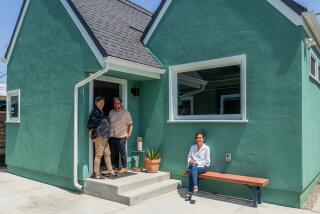More Like Home
CALABASAS — Lillian May keeps a packed suitcase in her bedroom because she is always ready to catch a car to Maryland.
“I don’t feel that old,” said May, 83. “I’ve always been in perfect health; that’s why I’m trying to get someone to take me home.”
May was a registered nurse who tended seriously injured troops at Walter Reed Army Hospital in Washington, D.C., during World War II. She lived in Maryland. She now roams the gardens and hallways of a locked center for people with dementia, where residents may keep pets or nap on a hallway sofa surrounded by shelves filled with encyclopedias, National Geographic magazines and hardcover books.
“They’re still adults, and they deserve the dignity to make choices,” said Candace R. Nicholson, an administrator at the Silverado Senior Living center, which celebrated its grand opening this week, although it actually opened for business in October.
Silverado is one of the nation’s growing number of assisted living centers, where elderly people with dementia can live with more freedom than usually allowed by nursing homes. For people with minimal special physical needs and relatively high incomes--Silverado costs $4,000 a month for a shared room--such places fulfill a growing need for an alternative to nursing homes, experts say.
“Families would like to see [relatives] in more homelike environments,” said Debra Cherry, associate executive director at the Alzheimer’s Assn., Los Angeles. “Assisted living is regarded more as a retirement facility. It looks less medical.”
The Aliso Viejo-based company that owns Silverado operates four other similar centers in Southern California and Utah. The Calabasas facility provides 1 1/2 acres of “wandering gardens” and four dining areas, including a private room reserved for special occasions with family members. A border collie named Cisco lives on the premises.
*
Frances West, 78, takes her two dogs with her wherever she goes at Silverado. As residents and workers danced to piano tunes and sang songs in a dining area Wednesday, West sang along, her small black-and-white dog Sadie in her arms.
“If I’m not singing for people, I sing for myself and the pups,” said West, who grew up in Texas and sang to troops with the USO during World War II. “I guess it’s the one thing that doesn’t make you unhappy.”
Thirty-five residents live in the complex, which has a capacity of 110. It provides 24-hour nursing services and weekly doctor visits, Nicholson said.
Most of the residents have Alzheimer’s, a brain disease caused by the loss of nerve cells that seems to result from the accumulation of a toxic protein in the brain, said Dr. Jeffrey Cummings, director of the Alzheimer’s Disease Center at UCLA.
Others at Silverado have mental difficulties caused by Parkinson’s disease or cardiovascular problems, administrator Nicholson said.
Instead of sedating patients with prescription drugs, staff members try to use distraction techniques, Nicholson said. Along the hallways are “memory boxes” filled with mementos from residents’ pasts, such as black-and-white photos of relatives, a World War II ration book and a small black antique sewing machine a woman used to make her family’s clothes.
Also on the walls are “redirection boards” containing doorbell buttons, chain door locks and a phone whose receiver plays talk radio.
“That way they don’t have to wake up their daughter at 2 a.m., but get the satisfaction of making a call,” Nicholson said.
*
Residents keep busy attending painting, current events and aquatic therapy classes, baking sweets and doing chores.
The fancy surroundings and humane care come at a hefty price, which Medicare and Medi-Cal do not cover. Only four Silverado residents have long-term insurance policies that cover their expenses, Nicholson said.
In contrast, nursing home care, which costs about $100 a day, accepts government payments, Cherry said. Nursing homes, which are licensed by the state Department of Health Services, are also constrained by more regulations than assisted care centers, she said.
Countywide, 1,152 residential care facilities for the elderly are licensed by the state Department of Social Services, said department spokesman John Gordon. He said the county has six lock-down facilities like Silverado and a total of 284 that have areas for patients with dementia.
Alzheimer’s sufferers experience loss of memory and language skills, disorientation, delusions and depression.
During the later stages, sufferers experience physical problems, such as incontinence, Cummings said.
“They tend to live in the past and have forgotten the present. They have trouble learning new things,” Cummings said. “Insight is one of the first things to be lost.”
More to Read
Sign up for The Wild
We’ll help you find the best places to hike, bike and run, as well as the perfect silent spots for meditation and yoga.
You may occasionally receive promotional content from the Los Angeles Times.






